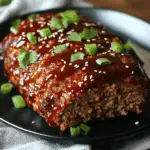This Egg Drop Soup is the epitome of simple elegance in a bowl. The silky ribbons of cooked egg float effortlessly in a fragrant, warming chicken broth infused with fresh ginger and a hint of pepper. The thinly sliced scallions on top add a burst of freshness and color, making every spoonful a comforting delight.
What makes this soup so beloved is its ease and versatility — you can whip it up quickly on a busy night or serve it as a starter at an elegant dinner. Its light yet nourishing quality is perfect for soothing cold days or when you crave something gentle on the stomach without sacrificing flavor. Whether you stick to the classic recipe or add your own twist, this soup is always a crowd-pleaser.
Full Recipe
Ingredients:
-
4 cups chicken broth (preferably low sodium)
-
2 large eggs
-
1 tablespoon cornstarch
-
2 tablespoons cold water
-
1 teaspoon fresh ginger, finely grated
-
1/2 teaspoon white pepper
-
2 scallions, thinly sliced
-
1 teaspoon soy sauce (optional)
-
Salt to taste
Directions:
-
In a medium pot, bring the chicken broth to a gentle boil over medium heat.
-
In a small bowl, whisk the eggs until smooth.
-
Mix the cornstarch with cold water until fully dissolved to create a slurry.
-
Slowly pour the cornstarch slurry into the simmering broth while stirring gently. This will slightly thicken the soup.
-
Add grated ginger, white pepper, and soy sauce (if using) to the broth. Adjust salt to taste.
-
Reduce heat to low and slowly pour the beaten eggs into the broth in a thin stream while stirring the soup gently in one direction to create silky egg ribbons.
-
Remove from heat once the egg ribbons are set but still tender.
-
Ladle the soup into bowls and garnish with sliced scallions. Serve immediately.
Prep Time: 5 minutes | Cooking Time: 10 minutes | Total Time: 15 minutes
Kcal: 90 kcal | Servings: 2 servings
Introduction to Egg Drop Soup
Egg Drop Soup is a timeless dish deeply rooted in Chinese cuisine, cherished for its simplicity, comfort, and delightful texture. This soup’s hallmark is the delicate, silky ribbons of egg that gently swirl in a warm, savory broth. It is a perfect example of how humble ingredients can come together to create a dish that is both nourishing and satisfying. The subtle flavors of chicken broth, fresh ginger, and scallions marry beautifully with the smooth egg ribbons, making Egg Drop Soup a beloved starter or light meal across the globe.
Origins and Cultural Significance
Egg Drop Soup has a rich history within Chinese culinary traditions. It is often referred to as “egg flower soup” due to the way the egg looks as it cooks in the hot broth, resembling floating petals or flowers. Originating from the Han Dynasty, this soup was originally a simple and affordable dish that utilized common pantry staples like eggs and broth. Over centuries, it has become a staple in Chinese households and restaurants alike, celebrated for its comforting qualities and ease of preparation.
This soup is often served as an appetizer in Chinese restaurants worldwide but is equally popular as a quick homemade meal. Its association with health and comfort has made it a go-to dish during cold seasons or when feeling under the weather. The soup’s light yet nourishing nature means it’s a popular choice for those recovering from illness or seeking gentle nourishment.
Flavor Profile and Texture
One of the most delightful aspects of Egg Drop Soup is its unique texture. The eggs, when poured slowly into the hot broth while stirring, form thin, silky ribbons that create a soft, velvety mouthfeel. This contrasts wonderfully with the clear, savory broth that carries the subtle flavors of chicken and ginger.
The broth itself is mild but deeply flavorful. Using a good-quality chicken stock, ideally homemade or low sodium, provides a clean base that lets the delicate ginger and scallions shine through. The grated fresh ginger adds a gentle warmth and brightness without overpowering the dish, while the scallions contribute a crisp, fresh finish.
White pepper is traditionally used to add a subtle spiciness that complements the broth’s savory notes. Soy sauce can be added sparingly for a touch of umami and saltiness, but it is not essential to the authentic flavor profile.
Health Benefits
Egg Drop Soup is not only delicious but also highly nutritious and light, making it an excellent option for a healthy diet. Eggs are a fantastic source of high-quality protein, essential amino acids, vitamins like B12, and minerals such as selenium. The soup’s broth provides hydration and electrolytes, especially when made from scratch with wholesome ingredients.
The inclusion of ginger offers additional health benefits. Ginger is known for its anti-inflammatory properties, ability to aid digestion, and immune-boosting effects. This makes Egg Drop Soup a soothing choice during times of cold or flu.
Furthermore, this soup is naturally gluten-free and low in calories, making it suitable for various dietary needs, including those watching their calorie intake or following gluten-free diets. Its simplicity means it can easily be adapted to suit vegan or vegetarian preferences by substituting the chicken broth for vegetable broth and omitting the egg or using an egg alternative.
Variations and Customization
While the classic Egg Drop Soup is simple, it is highly versatile and can be customized in countless ways to suit different tastes and dietary preferences. Some versions include adding vegetables like corn, peas, or mushrooms to add texture and nutrients. Others might include tofu for added protein or a splash of sesame oil for an aromatic finish.
Spice lovers can add chili flakes or a few drops of chili oil to bring heat to the dish. For a richer broth, a small amount of miso paste can be stirred in. You can also enhance the soup’s texture by adding cooked noodles or rice to make it more filling.
Many home cooks like to experiment with different herbs and seasonings — cilantro, fresh basil, or even a hint of garlic can be added to tweak the flavor profile. The key to a great Egg Drop Soup is balancing the savory broth with the gentle egg ribbons and fresh aromatics.
Tips for Perfect Egg Drop Soup
Achieving the perfect silky egg ribbons requires a few simple but important steps. First, the broth should be hot but not boiling vigorously when you add the egg. This allows the egg to cook gently and form those signature delicate strands rather than clumping into chunks.
Whisking the eggs thoroughly before pouring helps create a smooth texture. Pouring the egg slowly in a thin stream while stirring the broth gently in one direction ensures the ribbons form evenly.
Using fresh ingredients, especially homemade or good-quality chicken broth, will elevate the flavor significantly. Fresh ginger grated just before cooking releases the essential oils and brightness that pre-ground or dried versions lack.
Adjust seasoning at the end to your preference — a touch of salt, white pepper, or soy sauce can transform the soup subtly but meaningfully.
Serving Suggestions
Egg Drop Soup is versatile in how it can be served. It works wonderfully as a starter to a larger Chinese meal alongside dishes like fried rice, dumplings, or stir-fried vegetables. It also stands on its own as a light lunch or dinner, especially when paired with crusty bread or a fresh salad.
This soup is also fantastic when served in small bowls as part of a multi-course meal, offering a warm and gentle palate cleanser between heavier dishes.
Because it is quick and easy to prepare, it’s an excellent option for weeknight dinners or when you need a comforting meal without much fuss. The soup reheats well, although the texture of the egg ribbons is best enjoyed fresh.
Conclusion
Egg Drop Soup exemplifies the beauty of simple, well-executed cooking. With minimal ingredients and straightforward techniques, it creates a comforting, nourishing, and flavorful dish that has stood the test of time. Whether you’re a seasoned home cook or just starting your culinary journey, this soup is a reliable and satisfying recipe to keep in your repertoire.
Beyond its comforting taste and texture, Egg Drop Soup offers versatility, adaptability, and nutritional benefits that suit a variety of lifestyles and dietary needs. It brings warmth and ease to the table, whether enjoyed as a starter, light meal, or healing comfort food on a cold day. With a few tips and tweaks, you can make this classic dish your own and enjoy its silky, savory goodness whenever the craving strikes.






